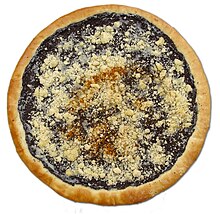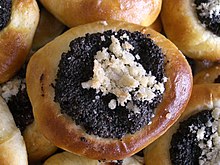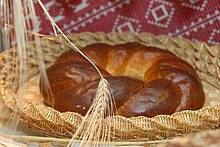Kolatsche
The Kolatsche , also Golatsche, Koláč (Czech, Slovak), Kolač (Slovenian, Serbian, Bosnian and Croatian) Kołacz (Polish), Кала́ч / Колач (Russian and Ukrainian), Kalács (Hungarian), Klo: tsch (Transylvanian) or Koiletsch (Yiddish) is a specific round cake of old Slavic origin with poppy seed, quark or plum jam filling (Austrian Powidl ), which plays a role in wedding rituals and is now also eaten in everyday life.
Origin and term
The Austro-German word Kolatsche is borrowed from the Czech koláč , which is derived from the Slavic word for “wheel” ( kolo ) (Czech kolo , Polish koło , Ukrainian коло ). The word koláč / kołacz etc. also generally means “cake” in various Slavic languages. Here, however, a special pastry is meant and thus Kolač / Kołacz in a specific meaning.
Originally the Kolatsche was a bread that was given to the bride and groom at the wedding. It was often decorated with a cross and had a ritual and symbolic meaning. Later it turned into a sweet pastry, but initially retained its meaning as a ritual pastry. Today Kolatschen are also eaten in everyday life. There are different regional variations.
The Czech Koláč
Czech Kolatschen are made from a yeast dough with fat and eggs. Round cut-out dough sheets are filled with a filling and baked without a mold. The filling can consist of a poppy seed preparation, quark preparation, nut butter, plum jam, jam, fruit or a combination thereof. Decorations with almonds, raisins or sprinkles are also possible. The quark preparation is made by mixing quark, sugar, egg yolk, possibly also butter, cornstarch and spices. The poppy seed preparation consists of ground poppy seeds, milk and sugar, which is boiled and then seasoned with spices such as cinnamon, vanilla, almonds, cloves or rum. The Kolač is usually around 10 cm in diameter. There is also a smaller version, the Koláček, with a diameter of around 5 cm.
A specialty is the Moravian Valašský Frgál , a koláč about 30 cm in diameter, which is baked without a mold on special occasions such as weddings and folk festivals. It is filled with pear, poppy seed, quark and plum preparations, with strawberries or apricots. The Frgál is also topped with sprinkles. It originally came to Moravian Wallachia when people emigrated from Romanian Wallachia to Moravia and is still baked there today.
The Polish Kołacz or Kołaczyk
In Poland, sweet Kołaczyki (some with cream filling) were given to the bride and groom as a wedding gift. The wedding bread Chleb weselny or the wedding cake Kolacz weselny consist of a sweet yeast dough and are heavily decorated with symbolic birds and flowers.
A sweet Kołaczyk with “white cheese” is widespread, often with plums or apples.
However, hearty fillings with onions, sauerkraut and Bryndza fresh sheep's cheese predominate in Polish cuisine . Kołaczyki of this type are usually used as an accompaniment to soups such as red barszcz or mushroom soup.
The Kołocz śląski from Upper Silesia is a pastry with apples, poppy seeds and crumble. Conceptually it is often confused with the Silesian crumble cake .
The Austrian Kolatsche
In the Austrian pastry and the pastry kolach or Golatsche the filling is, however, unlike Kołacz and kolac , closed at the top with batter. Therefore it is colloquially referred to as a tascherl . This form is still common in Austria.
Austrian Kolatschen are made from a firm, sweet yeast dough / yeast dough with a quark / quark filling, consisting of quark / quark , sugar , egg yolk and raisins . In other areas, kolatschen are also made from Danish pastry or puff pastry . They are then often simply referred to as junk z. B. according to their filling z. B. with curd cheese / quark then accordingly as curd cheese . In addition to curd cheese / quark, fillings can also be powidl / plum jam, pudding, apples, apricots, nuts, poppy seeds, cherry or vanilla cream. In Austria and Germany, in contrast to the round shape widespread in the Slavic region, the square shape is predominant.
The Kolatsche was already mentioned in the pomegranate cookbook of 1687 in the recipe "The good Bohemian Golatschen". In the "Appetit-Lexikon" (1894) by Robert Habs and Leopold Rosner you can find the Bohemian Kolatschen as Karlsbader or Troppauer Kolatschen. The Austrian cookbook author Katharina Prato describes them as round or square-shaped pastries with curd cheese without sugar, with almonds, with grape berries / grapes and gingerbread, with raisins or with poppy seed, nut or plum filling.
From Vienna, the Kolatschen found their way to Denmark in the 18th century, where they were known as Wienerbröd (Wienerbrot) or Copenhagen pastry in English-speaking countries as Danish pastry .
Колач and Кала́ч in Eastern Europe
The pastries known as Kolach and Kalach , which are baked in Eastern Europe , denote a somewhat different field than the Czech, Polish and Austrian Kolatschen, despite the great semantic similarity. The meaning extends to “white wheat bread” in the form of padlocks ( Moscow and Leningrad Kolatsche ) and “breadcrumbs”. In the Ukraine there are also the Watruschki , which are similar in shape to the Czech Kolatschen.
The pastry is also made of sweet yeast dough and is round, often circular, and is of a plurality of strands of dough skein-shaped raised braided. These are quite artfully formed. Fillings with poppy seeds, sugar, and sesame seeds are common. Also kolach and Kalach traditionally associated with the wedding ceremony. Decorations in the form of flowers, patterns or twigs attached to the baked goods are intended to prevent harmful spells.
Another form of Kalach is the Московский калач or Ленинградский калач , the Moscow or Leningrad Kolatsche . The Moscow Kolatsche is a bread roll made from a salty yeast dough that is shaped from a roll into an asymmetrical ring and cut horizontally at its thickest point. The Leningrad Kolatsche, on the other hand, is a sweet bun and contains sugar and fat. It is made from a round sheet of dough. B. a semicircular cut is punched with a cup. The resulting semicircular flap is bent over. When baked, both Kolatschen look similar and are reminiscent of handbags or padlocks in their shape. Both Kolatschen can be threaded with their hole on rods and stored that way.
The Jewish Koiletsch
The German-speaking Jews of southern Russia made plait-shaped pastries called Koiletsch and Koritko . The koiletsch also has a ritual function during the wedding. After the couple has left the wedding canopy or is alone in a room for the first time, an older aunt dances a Hasidic dance with the Koiletsch (like with a dance partner) and asks: “Was villstu?” (Yiddish “What do you want ? ”) What is meant is:“ The bride or the bread? ”The Koiletsch is described as a loaf with many twists and turns and was eaten at noon on the Sabbath in the USA.
The pîrim koiletsch is the cake or white bread for the Jewish festival of Purim .
The Kolač in the Balkans
The term "'Kolač" in the languages of the Balkans is also not congruent with the Czech and Polish Kolatsche. As in Czech and Polish in general , Kolač means cake , so it is very difficult to define a specific sweet pastry here. Slavski Kolač is a specific type of pastry that follows the concepts and content described above . It consists of sweet yeast dough with oil and egg, which is more or less plaited and baked in a round shape. Often it is decorated on the top with other dough braids and decorations with symbolic meaning (flowers, twigs, leaves, birds, grapes, religious symbols), which are partly made from a harder dough made of water and flour.
The Slavski Kolač is firmly integrated into the Slava ritual , a Christian Orthodox family festival celebrated in honor of the family patron saint. The Slavski Kolač is prepared on the eve of the Slava by the woman of the house, with some holy water if available, and blessed in the church. The kolač is consecrated again the next day by the priest and, after further ceremonies, it is eaten along with other ritually significant dishes.
There is a song of the same name about Slavski Kolač by the Serbian singer Nada Topcagic from 1996.
Colacul and Kloatsch in Romania and the Republic of Moldova
The Transylvanian Klo: tsch or Kloatsch also has a meaning as a wedding cake .
In Romania and the Republic of Moldova there is the Colacul or Colac (the ending -ul is only the masculine definite article in Romanian ), a ring-shaped sweet yeast plait with symbolic meaning and used in rituals. At weddings the zopfförmige, decorated with flowers and baked without form plays Colac from sweet yeast dough a ritual role as a gift to the newlyweds. On November 30th, the day of St. Andrew (Sfântul Andrei), unmarried girls meet and bake a Colac de Andrei each . Once cooled, they put a clove of garlic on top and take it home with them. When the garlic clove begins to sprout, it is considered a lucky sign. At Easter, the Pască is baked, also a ring-shaped braid made of sweet yeast dough, which is specially made for this holiday. This is filled in the middle with a cream cheese preparation made from Urda , raisins and sugar.
literature
- Mária Hajková: Múčniky. Baking book: cakes, pies, pastries, hearty pastries, sweet pastries, desserts, creams, ice cream. Verlag für die Frau, Bratislava / Leipzig 1986, ISBN 3-7304-0020-7 .
- Maria Lemnis, Henryk Vitry: Old Polish cuisine and Polish table manners. Warsaw 1984, ISBN 83-223-1817-0 .
- Robert Strybel: Polish Holiday Cookery and Customs. Hippocrene Books, New York NY 2003, ISBN 0-7818-0994-0 (English)
- А. В. Gura, А. А. Plotinkova: Kalach. Slavyanskiye Drevnosti: Etnolingvisticheskiy slovar . Pod red. NI Tolstogo, Institut Slavyanovedeniya RAN, M .: Mezhdunarodnyye Otnosheniya, 1999, part 2, ISBN 5-7133-0982-7 , pp. 439–442 (Russian)
- PM Plotnikov, MF Kolesnikov: 350 sortov khlebo-bulochnykh izdeliy. Moscow 1940 (Russian)
See also
Web links
- Viennese Danish pastries . Entry No. 182 in the register of traditional foods of the Austrian Federal Ministry for Agriculture, Regions and Tourism .
Individual evidence
- ^ A b Karen Eckhardt: A culinary journey through the Czech Republic. ( Memento of the original from January 22, 2008 in the Internet Archive ) Info: The archive link was automatically inserted and not yet checked. Please check the original and archive link according to the instructions and then remove this notice.
- ↑ a b Kołacz. In: Zygmunt Gloger: Encyklopedia staropolska ilustrowana. Warsaw 1958.
- ^ Bohemian Kolatschen, in: Lunch for One, Blog
- ↑ Martina Schneibergová: Like in grandma's time: EU seal of approval for cakes "Valašský frgál". In: Radio Prague, December 9, 2013
- ↑ socwebs: Korowaj - chleb weselny, in: Obyczaje Weselne, May 27, 2012
- ↑ Maria Lemnis, Henryk Vitry: W staropolskiej kuchni i przy polskim stole. Warsaw 1986.
- ↑ Anett Böttger: How Silesian can German streusel cake be? In: The world. 11th. November.2013.
- ↑ Peter Wehle: Do you speak Viennese? From Adaxl to Zwutschkerl. Ueberreuter, Vienna 2003, ISBN 3-8000-3961-3 .
- ^ IREKS Arkady Institute for Bakery Science (ed.): IREKS ABC of the bakery. 4th edition. Institute for Bakery Science, Kulmbach 1985.
- ↑ Kalach. In: Slovari i entsiklopedii na Akademike.
- ↑ Kalach. In: Kulinarnyy slovar. Slovari i entsiklopedii na Akademike.
- ↑ PM Plotnikov, MF Kolesnikov: 350 sortov khlebo-bulochnykh izdeliy. Pishchepromizdat 1940, No. 61 Kalachiy Leningradskiye and No. 55 Kalachiy Moskovskiye
- ↑ Moskovskiy kalach, instructions for making the Moscow Kolatsche, in: Youtube, channel by neravu, uploaded February 10, 2012 (Russian)
- ↑ Leningradskiy Kalach, in: Pechendoma, Avtorskiy blog o domashney vypechke, February 10, 2012 (Russian) ( Memento of the original from July 20, 2014 in the Internet Archive ) Info: The archive link was inserted automatically and has not yet been checked. Please check the original and archive link according to the instructions and then remove this notice.
- ↑ Kalach "Moskovskiy", in: Pechendoma, Avtorskiy blog o domashney vypechke, February 10, 2012 (Russian) ( Memento of the original from July 27, 2014 in the Internet Archive ) Info: The archive link was inserted automatically and has not yet been checked. Please check the original and archive link according to the instructions and then remove this notice.
- ^ Vienna, Verein Für Volkskunde In: Österreichische Zeitschrift Für Volkskunde, pp. 99–100, London 2013, original 1907 ( Memento of the original from September 24, 2015 in the Internet Archive ) Info: The archive link has been inserted automatically and has not yet been checked. Please check the original and archive link according to the instructions and then remove this notice.
- ^ Erez Komarovsky: Rising to the occasion. In: Haaretz. July 21, 2006.
- ↑ PRAKJM: The Silent Meal. In: The Jewish Sentinel. The Chicago Weekly from 1911 to 1996, in: Illinois Digital Archives, No. 00050005 5.
- ↑ Jechiel Bin-Nun: Yiddish and the German dialects. 2nd Edition. Berlin 1973, ISBN 3-484-10170-9 , pp. 49 and 121.
- ↑ Violeta Hajduk: Slavski kolac. In: Tortekolaci.com (Serbo-Croatian)
- ↑ SLAVSKI KOLAČ, in: Youtube-Kanal von KRAJINA019, uploaded December 23, 2013
- ↑ Marjana Klemenšek: Okraski iz testa. In: Youtube, Marjana Klemensek's channel, uploaded on November 26, 2010. The video shows how decorations are made from dough.
- ↑ SPC: Kolač se može praviti i postan kada krsno ime pada u posne dane. In: Tortekolaci.com (Serbo-Croatian)
- ↑ Nada Topcagic: Slavski Kolač, in: Youtube channel by Nada Topcagic, upload of May 3, 2013
- ↑ Martina Šiffalovičová: Carpathian German phraseology. Diss., Bielefeld 2008
- ↑ der Ijel: Description of the use of the Kloatsch, in :hagenbuerger.de, January 26, 2012
- ↑ Colac on Dexonline
- ↑ Angela Bostanica: Colacul miresei. In: Moldovenii
- ↑ Andrei Bordier: Colacul Miresei. In: Andrei Bordier's YouTube channel, uploaded on September 18, 2010.
- ^ Ingrid F .: Noaptea Sfântului Andrei. In: Romania advent calendar: 01.12.2007








